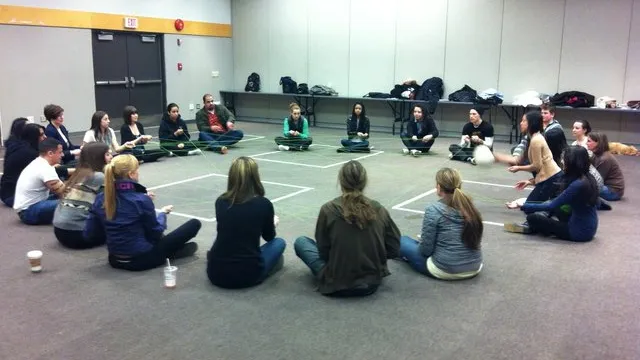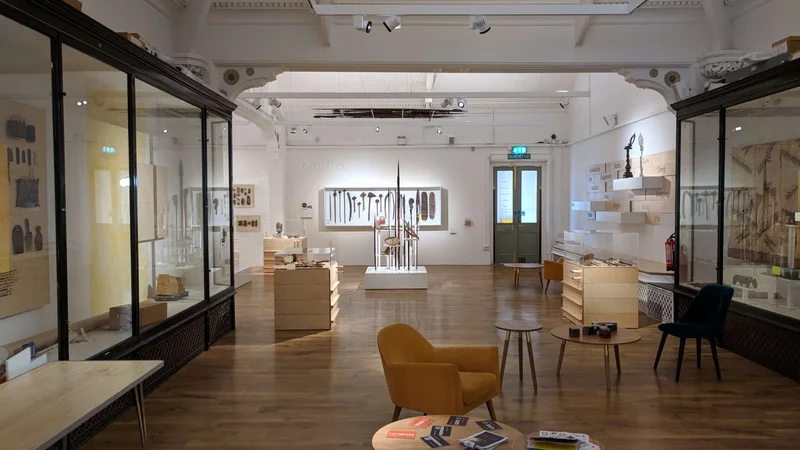Trauma-informed practice means supporting one another. This is perhaps the most important work of all—and often the most overlooked. We tend to focus on visitors, on exhibitions, on public-facing initiatives. But the truth is simpler and closer to home: if staff cannot care for one another, they cannot care for anyone else. The foundation of trauma-informed practice in a museum begins not in the galleries but in the break room, in the quiet moment when one colleague notices another's distress and offers support by saying I see you're struggling, and I'm here.
When asked, most people report that they are good at supporting colleagues who are experiencing difficulty. However, the skills required for genuine support can be observed and evaluated, and when we do that, we find that most people—despite good intentions—are not highly skilled in this area. This is not a failure of character but a reality of complex skills, and supporting a colleague through emotional distress is one of the most complex skills of all. It involves immersion in the unpredictable, often chaotic, inner landscape of another person. Nothing is more dynamic, multi-layered, and mysterious.
Before we think about helping others, support begins with recognizing the emotional undercurrents that shape our own behavior. This is challenging for everyone. It requires us to notice what is happening in the moment and to manage our own internal feelings, histories, responses, biases, and reactions—all at the same time. Supporting colleagues begins with self-awareness and extends outward into our relationships and interactions.
The Foundation: (Try to) Know Yourself First
A Collections staff member sits in the storage area, eyes unfocused, hands trembling slightly as they hold a child's shoe from a residential school. A colleague enters, sees the moment, and wants to help. The impulse is immediate: I should do something. I should say something. I should fix this.
But the most skillful response often begins with a pause. What am I feeling right now? Is this resonating with something in my own history? Am I uncomfortable with this person's emotion? Do I want them to stop feeling this way because it makes me uncomfortable? These are not easy questions, and they require a kind of brutal honesty with ourselves that our workplace cultures rarely encourage.
When we become aware of our emotional reactions, we can better manage them, ensuring that we are not bringing our own unresolved feelings into our interactions. This is particularly important in emotionally charged situations, where reactivity can quickly escalate if we are not grounded. By regularly reflecting on our own emotional states and motivations, and by working on our own unresolved issues, we build the foundation for a more authentic and supportive presence with others.
In this sense, the skills of support are primarily focused inward—on ourselves—rather than outward, toward our interactions with those we seek to assist. This is not selfishness. It is the only way to avoid causing harm.
Presence, Not Performance
Support is an active practice, not a passive state. One of the primary challenges we face lies in setting aside our judgments and preconceptions. We are constantly interpreting each other's words and actions, often in ways shaped by our own past experiences, emotional wounds, and assumptions. This is natural, but effective support requires that we move beyond these tendencies. We learn to be curious rather than judgmental, to recognize that another person's experience is both unique and valid. Support asks us to withhold our instinct to analyze, question, or fix the other person's emotions and instead to remain open, accepting, and present.
What does presence actually look like? It is not about having the right words or the perfect gesture. Often, it is simpler than that. It is the colleague who sits down beside you without speaking. It is the person who brings you tea without asking if you need it. It is the manager who notices you've been quiet for three days and says, quietly, How are you doing?—and then waits for a real answer.
Presence requires congruence: consistency between our actions, words, and intentions. People are highly attuned to subtle cues—body language, tone of voice, the quality of our attention. They can quickly detect (consciously or otherwise) when these signals lack alignment. In supportive practice, congruence means showing up in a way that genuinely reflects our intentions to listen and be with the other person. It means being mindful of our own emotional state and working to bring our words and behaviors into alignment with the supportive role we intend to offer.
This congruence is, at times, excruciatingly difficult. We may feel impatient but need to appear calm. We may feel anxious but need to offer steadiness. We may be emotionally activated by someone's story but need to remain grounded. All of this is part of the work—and it is work, make no mistake. The person we are supporting deserves our authenticity, but they also deserve our effort to manage our own reactions so that we do not burden them with our discomfort.
Congruence is the only means by which we build trust, which is a critical element in any healing journey. When a colleague senses that we are genuinely present—that we are not performing care but embodying it—they can begin to feel safe enough to share what they are actually experiencing.
Boundaries: The Structure That Enables Care
Support is inherently boundaried. It is not about merging our experiences with someone else's or feeling overwhelmed by their emotions. This distinction is crucial and often misunderstood. Many people believe that good support means feeling what the other person feels, taking on their pain, carrying their burden. This is not support; it is fusion, and it helps no one.
Developing this skill requires that we balance openness with healthy boundaries—remaining present without being subsumed by another person's pain, and without being dismissive of it. This is especially crucial in situations where colleagues are experiencing trauma, grief, or overwhelming stress. The concept of containment—holding a stable space for others while managing our own reactions—becomes central here.
Imagine a research team member who has just completed oral history interviews with genocide survivors. They return to the office visibly shaken. A colleague approaches and says, That must have been so hard. I can't imagine. The words are kind, but they deflect. They create distance rather than connection. Now imagine instead: It seems like you've had a strong reaction. Tell me how I can best support you right now.
The second response offers presence without presumption. It maintains boundaries—the colleague is not trying to take on the other person's experience—while also creating space for whatever the person needs in the moment. This is the paradox of boundaries in care work: they are not walls that separate us but structures that enable genuine connection.
By practicing grounding techniques, breathwork, or mindful presence, we can maintain the emotional steadiness needed to offer genuine support without losing our own center. When we lose our center—when we become flooded by the other person's emotion or our own reaction to it—we cease to be helpful. We become another person in distress, and now there are two people who need support instead of one.
The Urge to Fix
Showing support toward another person without interjecting, advising, or trying to fix is one of the most challenging aspects of care. Often, we instinctively move toward offering solutions or making suggestions. Have you tried talking to HR? Maybe you should take a few days off. You know, when I went through something similar, I found that... These responses, while well-intentioned, can sometimes hinder the other person's ability to process and express their feelings.
Why do we do this? Often because we are uncomfortable. Sitting with someone's pain—truly sitting with it, not trying to make it go away—is hard. It activates our own vulnerabilities, our own fears, our own unresolved grief. Fixing feels like action, and action feels like helping. But genuine support is about allowing people to explore their thoughts and emotions without interference, helping them feel heard, seen, and respected.
This does not mean we never offer practical help. Sometimes a colleague needs very concrete assistance: coverage for their shift, information about EAP services, someone to walk them to their car. But we offer these things after we have listened, after we have been present, after the person has had space to simply be with what they are experiencing.
There is one question that can be genuinely helpful here: What do you need? This question is different from the others we typically avoid. It returns agency to the other person. It acknowledges that they are the expert on their own experience. It does not presume to know what would help; it asks them to tell us. And often, what they need is not a solution but simply our presence, our willingness to sit with them in their difficulty without rushing to make it better. When they do identify a concrete need, we can respond with possibilities rather than directives: I'm wondering if it might help to... or It sounds like you might need... These prompts maintain focus on supporting the other person's own understanding of what they require.
Peer Check-Ins: Simple Gestures, Deep Impact
Supporting colleagues does not always require formal interventions or dramatic moments. Often, the most powerful support happens through simple, consistent gestures. Just checking in... This simple opening, offered genuinely and with time to hear whatever follows, can be transformative. But many staff hesitate, fearing intrusion or not knowing how to respond if what emerges is difficult.
The practice begins with normalizing such exchanges. In a trauma-informed culture, checking in becomes routine rather than exceptional—a signal of care rather than alarm. It seems like things have been heavy lately. These moments work best when they come from a place of genuine presence rather than obligation, when the person offering support is prepared to actually listen to whatever unfolds.
A crucial skill here involves how we engage. Questions—even well-intentioned ones—can inadvertently shift the conversation away from the other person's experience and toward our own needs as listeners. When we ask How are you feeling? or What's wrong? or Do you want to talk about it?, we are, in a sense, directing the conversation according to our framework, our curiosity, our discomfort with silence. Questions make the conversation about us.
Instead, we can offer presence through prompts that reflect and invite rather than query:
- Just checking in...
- It looks like...
- It sounds like...
- I get the sense that...
- It seems like...
- So it's like...
- Help me understand...
- What you're saying is...
These prompts open space without directing it. They reflect what we notice without presuming to know what it means. They invite the other person to continue, to deepen, to clarify—on their own terms. It sounds like today was difficult leaves room for the person to say more, or to say nothing, or to correct our perception. Was today difficult? puts them in the position of answering our question rather than exploring their experience.
This distinction may seem subtle, but it matters enormously. The difference between It seems like you're carrying something heavy and Are you okay? is the difference between offering presence and seeking reassurance. The first invites; the second probes.
These prompts must be individualized to each person's temperament, background, and style of speaking. What works naturally in one person's vocabulary may sound stilted in another's. A Collections staff member comfortable with metaphor might say It's like you're walking through fog today. Another might simply offer I'm noticing you're quieter than usual. The specific words matter less than the orientation they represent: reflecting rather than questioning, inviting rather than directing, being with rather than solving.
When a colleague responds to our presence—when they begin to share what they're experiencing—our role remains the same: to listen, to reflect, to stay grounded in our own center while holding space for theirs. We do not need to have answers. We do not need to fix what they're feeling. We need only to be present, authentic, and steady.
Normalizing Breaks and Recovery
Working with trauma-related content can be exhausting. The Collections staff member who spends weeks cataloging residential school materials, the curator developing an exhibition on genocide, the researcher conducting interviews with survivors—these are not occasional emotional challenges but ongoing exposures that accumulate over time. Ideally, breaks are normalized: time to breathe, step outside, rotate to different tasks. In practice, guilt or workload may prevent this.
The culture we create around breaks matters enormously. If breaks are seen as weakness, staff will push through exhaustion until they break down. If breaks are normalized as professional responsibility—as necessary for doing this work well—staff are more likely to take them. Leaders play a crucial role here, not just in policy but in modeling. The manager who says I'm stepping out for a walk, I need to clear my head gives permission for others to do the same. The colleague who suggests, Let's take a break and come back to this tomorrow acknowledges that pacing matters.
This is not about avoiding difficult work. It is about recognizing that humans are not machines. Our capacity for emotional exposure has limits, and honoring those limits is not a failure but a form of skill. The marathon runner who stops for water is not giving up; they are ensuring they can continue. The same principle applies here.
Recognizing Activation in Ourselves and Others
Colleagues may show signs of the body's stress responses: fight, flight, freeze, or orient (or, to put these in non-clinical terms: bullying, checking out, shutting down, and spinning). A staff member who snaps irritably at minor things may be in fight mode. One who withdraws, stops responding to emails, avoids meetings may be in flight or freeze. Another who seems scattered, unable to focus, constantly worried about what might happen next may be in orient mode, hypervigilant to threat.
Ideally, we learn to notice these states in ourselves first—to recognize when our own nervous system is activated—and then to notice them with compassion in colleagues. In practice, behaviors are easily misread. The withdrawn colleague is labeled lazy. The irritable one is called difficult. The scattered one is judged incompetent. A trauma-informed lens reframes these judgments. We ask instead: What has this person been exposed to? What might be happening beneath the surface? How might I offer support rather than criticism?
This does not mean excusing harmful behavior. Boundaries still matter; accountability still matters. But it means starting from a place of curiosity and compassion rather than judgment. It means recognizing that someone's current behavior may not reflect who they are but rather what they are trying to survive.
Boundaries and Balance: When to Step Back
Supporting colleagues does not mean trying to save them. This is a crucial distinction, and one that many caring people struggle with. We see someone in pain, and we want to help. We offer support, then more support, then we find ourselves thinking about their situation at home, losing sleep, feeling responsible for their well-being. This is not support; this has become fusion or codependency, and it helps neither person.
Healthy support requires that we know our limits. We can offer presence, we can listen, we can provide practical help when appropriate—but we cannot fix another person's trauma, and we cannot carry their pain for them. When we try, we harm ourselves and ultimately become less able to offer genuine support. We become depleted, resentful, or burned out.
Ideally, staff learn to recognize when they are approaching their own limits and feel empowered to step back without guilt. I care about you, and I want to support you, but I'm realizing I need to take care of myself right now. This is not abandonment; it is honesty. And often, it models for the other person that boundaries are healthy and necessary.
In practice, boundaries can blur, especially in workplace cultures that reward self-sacrifice and punish self-care. The aspiration is to normalize balance: to create an environment where saying I need to pause is respected rather than seen as weakness, where multiple people can offer support so no one person carries the full weight, where professional resources (such as external counseling) are normalized and accessible.
Structured Support: Making It Reliable
While informal gestures matter enormously, structured systems make support reliable. Regular debriefs after difficult projects. Small peer support groups that meet monthly. Mentorship programs that pair newer staff with those who have more experience navigating the emotional challenges of this work. Ideally, these become part of routines rather than special interventions.
In practice, time and resources may limit formal structures. But even modest systems can help. A standing meeting slot, every two weeks, designated as optional well-being time when colleagues do an activity together (share a meal, go for a walk, attend a cultural event). A shared document where staff can request support or offer it. A rotation system ensuring that no one person handles the most emotionally demanding work continuously.
The aspiration is to integrate support into daily operations rather than treating it as separate or supplementary. Just as exhibitions are planned, objects are cataloged, and budgets are managed, so too is care for one another built into the structure of how the museum functions.
The Tone Starts at the Top
Leaders set the tone for whether supporting colleagues is valued or merely stated. Ideally, managers model openness, acknowledge their own limits, and encourage the balance they wish to see. I need to take a day to recover from that meeting. It was harder than I expected. A leader who says this gives permission for others to do the same.
In practice, pressures may push leaders toward stoicism. They may feel they must project strength, competence, invulnerability. This is understandable—and it undermines trauma-informed culture. When leaders hide their struggles, staff learn that vulnerability is weakness. When leaders admit difficulty while also demonstrating resilience, staff learn that both are possible: we can struggle and we can continue, we can hurt and we can heal.
The aspiration is to redefine authority not as invulnerability but as authenticity—as the capacity to show up fully human, with limits and needs, while still holding responsibility and care. This is perhaps the most challenging shift of all, because it asks leaders to be vulnerable in ways that traditional workplace culture has long discouraged. But it is also the most powerful, because it creates permission for everyone else to be human too.
Toward a Culture of Peer Care
Supporting colleagues is not separate work but woven into daily life. Ideally, care is expected and embedded into how work happens: in meetings, in how projects are assigned, in how stress is acknowledged, in how recovery is supported. In practice, this can be uneven, inconsistent, dependent on individual personalities rather than organizational culture.
The aspiration is for museums to cultivate a culture where everyone knows that no one carries trauma alone. Where checking in is routine. Where breaks are normalized. Where saying I'm struggling is met not with judgment but with What do you need? How can I help? Where leaders model vulnerability. Where boundaries are respected. Where support is not heroic but ordinary—just how things are done.
This culture does not emerge from a single workshop or policy document. It emerges from countless small moments, repeated over time, until they become the norm. A colleague notices another's distress and pauses to ask how they are. Someone offers to cover a shift when they see a coworker is exhausted. A manager acknowledges that a project was emotionally difficult and thanks the team for their care in handling it. These moments, accumulated, become culture.
The work of supporting colleagues is ongoing, imperfect, and essential. It requires us to be aware of ourselves first, to practice presence without performance, to maintain boundaries while remaining open, to resist the urge to fix, to offer simple gestures consistently, to normalize recovery, to notice activation with compassion, to know when to step back, to create structures that make support reliable, and to model the vulnerability we wish to see. None of this is easy. All of it is necessary. And together, it forms the foundation on which trauma-informed practice rests.
Next
Guide Navigation
The introductory page of the guide provides the context and rationale for trauma-informed museum practices and includes an overview of each page.
Understanding Trauma in Museum Contexts explores how trauma operates as a complex, ecological phenomenon affecting visitors, staff, and community partners. It examines the neuroscience of trauma responses, the patterns that emerge from person-environment interactions, and why museums need this foundational knowledge.
Considerations for Trauma-Informed Training addresses the personal dimension of this work—why trauma-informed training must be fundamentally different from typical professional development, how to build skills safely, and the importance of self-awareness and empathy as foundations for supporting others.
Core Principles of Trauma-Informed Practice outlines five interconnected principles—safety, trust, belonging, empowerment, and empathy—that guide all trauma-informed work. These are not implemented once but practiced continually, shaping how exhibitions are designed, how staff interact, and how partnerships are formed.
Supporting Colleagues examines what it means to care for one another in workplaces where exposure to traumatic content is routine. It explores the skills of presence, the importance of boundaries, and how to create a culture where supporting each other becomes ordinary rather than exceptional.
Trauma-Informed Exhibition Planning addresses the challenge of creating exhibitions that convey difficult truths with honesty while respecting visitor wellbeing. It offers practical strategies for content advisories, visitor choice, regulation spaces, and creative engagement that honors both truth-telling and care.
Working with Community Partners explores how to build genuine, reciprocal partnerships with communities whose traumatic histories museums represent. It emphasizes the importance of multiple sessions over time, incorporating creative work alongside discussion, and creating conditions where trust can develop.
Sustaining the Practice addresses how trauma-informed approaches become embedded in organizational culture rather than remaining isolated initiatives. It explores onboarding, documentation, leadership modeling, policy alignment, and the long-term work of creating environments where care is expected and practiced.



